Assessment of Influencing Factors on Consumer Behavior Using the AHP Model
Abstract
1. Introduction
1.1. Problem Statement
1.2. Significance of the Study
1.3. Literature Review
1.4. Research Objectives and Hypothesis
2. Materials and Methods
- Representativeness: A random sample provides a representative sample of the population being studied, ensuring that the results are generalizable to the larger population. This helps to minimize bias, and increase the validity and reliability of the research.
- Avoidance of Sampling Bias: A random sample can help to avoid sampling bias, where certain groups or individuals are overrepresented or underrepresented in the sample. This can result in biased results and can limit the generalizability of the findings.
- Increased Precision: A random sample can increase the precision of the results, reducing the margin of error and increasing the accuracy of the research. This helps to ensure that the findings are robust and reliable.
- Ethical Considerations: Selecting a random sample helps to ensure that all individuals in the population have an equal chance of being included in the study. This helps to ensure that the study is conducted ethically and respects the rights of all participants.
- Improved Generalizability: The use of a random sample helps to ensure that the findings are generalizable to the larger population, making the results more applicable to real-world situations. This is essential for informing business decisions and developing effective marketing strategies.
- Determine the aim, criteria, and variants of the decision problem—to compile the hierarchical structure. This process is often referred to as problem decomposition into a hierarchical tree.
- Select experts who will generate a pairwise comparison matrix (A = n × n).
- 3.
- Using Saaty’s [56] scale, the relative importance of two criteria is calculated.
| n | 1 | 2 | 3 | 4 | 5 | 6 | 7 | 8 | 9 | 10 | 11 | 12 | 13 | 14 |
| R.I. | 0 | 0 | 0.58 | 0.89 | 1.11 | 1.25 | 1.35 | 1.40 | 1.45 | 1.49 | 1.51 | 1.48 | 1.56 | 1.57 |
- 4.
- The weights of the relative criteria are obtained after the matrix is previously normalized.
- aij > 0, for i = 1, 2, …, n; j = 1,2, …, n,
- aji = l/aij, for i= 1,2, …, n; j = 1,2, …, n
- 5.
- The distribution of the criteria should be specified.
- 6.
- Calculate the criteria weight vector.
- 7.
- Check the consistency of pairwise judgments.
- 8.
- From the obtained results, a ranking list is created by the degree of priority in relation to the goal.
3. Results and Discussion
Synthesizing Pairwise Comparison
4. Conclusions
- Complexity of Consumer Behavior: Consumer behavior is a complex and multifaceted phenomenon that involves various psychological, social, personal, and cultural factors. Studying all these factors can be challenging and requires a significant amount of time, resources, and expertise.
- Rapidly Changing Consumer Trends: Consumer behavior is continually evolving and new trends are emerging at a fast pace. Keeping up with these changes can be difficult for researchers and it may be challenging to capture the nuances of consumer behavior accurately.
- Limited Funding: Conducting research in the field of consumer behavior can be expensive and securing funding can be challenging. This can limit the number of studies that can be conducted, and researchers may have to prioritize certain areas of research over others.
- Lack of Collaboration: Collaboration among researchers, businesses, and policymakers can be essential in advancing research in the field of consumer behavior. However, there may be a lack of collaboration among these stakeholders, which can limit the scope and impact of research in this field.
- Ethical Considerations: Research involving human subjects must adhere to strict ethical guidelines, which can be time-consuming and costly. These guidelines can also limit the scope of research in some areas.
- Sample Size: The size of the sample can significantly impact the generalizability of the findings. Small sample sizes may not be representative of the population, while large sample sizes may be difficult and expensive to obtain.
- Time Constraints: Conducting longitudinal studies can provide valuable insights into consumer behavior over time, but they can be time-consuming and expensive. Researchers may face challenges in securing funding for long-term research projects.
- Limited Access to Data: Access to data can be a significant limitation in consumer behavior research. Some data, such as sales data or customer data, may be proprietary and difficult to obtain. Additionally, data privacy laws and regulations may limit the use of certain types of data.
- Influence of Social Desirability Bias: Social desirability bias occurs when participants respond in a way they believe is socially acceptable rather than their true feelings or behaviors. This can be a limitation in self-reported studies and researchers must take measures to reduce the impact of this bias.
Author Contributions
Funding
Informed Consent Statement
Data Availability Statement
Conflicts of Interest
References
- Al-Ghaswyneh, O.F. Factors affecting the consumers’ decision behavior of buying green products. ESIC Mark. Econ. Bus. J. 2019, 50, 389–418. [Google Scholar] [CrossRef]
- Qazzafi, S. Factor affecting consumer buying behavior: A conceptual study. Int. J. Sci. Res. Dev. 2020, 8, 45–57. [Google Scholar]
- Nosi, C.; Zollo, L.; Rialti, R.; Ciappei, C. Sustainable consumption in organic food buying behavior: The case of quinoa. Br. Food J. 2020, 122, 976–994. [Google Scholar] [CrossRef]
- Dias, A.; Sousa, B.; Santos, V.; Ramos, P.; Madeira, A. Wine Tourism and Sustainability Awareness: A Consumer Behavior Perspective. Sustainability 2023, 15, 5182. [Google Scholar] [CrossRef]
- Ramya, N.; Ali, S.M. Factors affecting consumer buying behavior. Int. J. Appl. Res. 2016, 2, 76–80. [Google Scholar]
- Šostar, M.; Ramanathan, N.H.; Serzhanov, V. The Impact of COVID-19 Pandemic on Consumer Behavior. Telematique 2023, 22, 617–622. [Google Scholar]
- Jurík, L.; Horňáková, N.; Šantavá, E.; Cagáňová, D.; Sablik, J. Application of AHP method for project selection in the context of sustainable development. Wirel. Netw. 2020, 28, 893–902. [Google Scholar] [CrossRef]
- Šostar, M.; Chandrasekharan, H.A. Importance of Nonverbal Communication in Sales. In Proceedings of the 8th International Conference “Vallis Aurea” Focus on: Tourism & Rural Development, Polytechnic in Pozega, DAAM Vienna, Požega, Croatia, 8–10 September 2022; pp. 451–460. [Google Scholar]
- Michman, D.R.; Mazze, M.E.; Greco, J.A. Lifestyle Marketing: Reaching the New American Consumer; ABC-CLIO: Santa Barbara, CA, USA, 2008. [Google Scholar]
- Blackwell, R.D.; Miniard, P.W.; Engel, J.F. Consumer Behavior; Dryden Press, Harcourt College Publishers: Fort Worth, TX, USA, 2021. [Google Scholar]
- Etim, S.N.; Ebitu, T.E. Comparative Analysis of Business and Consumer Buying Behavior and Decisions: Opportunities and Challenges in Nigeria. Br. J. Mark. Stud. (BJMS) 2019, 7, 72–86. [Google Scholar]
- Solomon, R.M. Consumer Behavior: Buying, Having, and Being, Global Edition, 12th ed.; Pearson: London, UK, 2017. [Google Scholar]
- Fruth, A.; Neacsu, M. Online Consumer Reviews as Marketing Instrument. Knowledge Horizons. Economics 2014, 6, 128–131. [Google Scholar]
- Schiffman, L.G.; Kanuk, L.L. Consumer Behavior, 6th ed.; Prentice Hall: Hoboken, NJ, USA, 1997. [Google Scholar]
- Suroto, K.S.; Fanani, Z.; Nugroho, B.A. Factors influencing consumer’s purchase decision of formula milk in Malang City. J. Bus. Manag. 2013, 9, 95–99. [Google Scholar] [CrossRef]
- Kotler, P.; Wong, V.; Saunders, J.; Armstrong, G. Principles of Marketing; Mate d.o.o.: Zagreb, Croatia, 2006. [Google Scholar]
- Kotler, P.; Keller, L.K. Marketing Management, 14th ed.; Pearson Education: New York, NY, USA, 2012. [Google Scholar]
- Shareef, M.A.; Mukerji, B.; Dwivedi, Y.K.; Rana, N.P. Social media marketing: Comparative effect of advertisement sources. J. Retail. Consum. Serv. 2019, 46, 58–69. [Google Scholar] [CrossRef]
- Danish, M.; Ali, S.; Ahmad, M.A.; Zahid, H. The Influencing Factors on Choice Behavior Regarding Green Electronic Products: Based on the Green Perceived Value Model. Economies 2019, 7, 99. [Google Scholar] [CrossRef]
- Cao, Y.; Ajjan, H.; Hong, P. Post-purchase shipping and customer service experience in online shopping and their impact on customer satisfaction: An empirical study with comparison. Asia Pac. J. Mark. Logist. 2018, 30, 400–416. [Google Scholar] [CrossRef]
- Liu, C.; Sun, K.; Liu, L. The Formation and Transformation Mechanisms of Deep Consumer Engagement and Purchase Behavior in E-Commerce Live Streaming. Sustainability 2023, 15, 5754. [Google Scholar] [CrossRef]
- Malhotra, N.; Nunan, D.; Birks, D. Marketing Research: An Applied Approach, 5th ed.; Pearson: London, UK, 2017. [Google Scholar]
- Bin, S. Social Network Emotional Marketing Influence Model of Consumers’ Purchase Behavior. AI-Driven Sustain. Comput. Soc. Netw. E-Commer. Mark. 2023, 15, 5001. [Google Scholar] [CrossRef]
- Nawi, C.N.A.A.C.M.; Ismail, N.L.; Rashidi, N.Z.A.M.; Aziz, N.N.F.N. Determining the Contributing Factors Towards Consumer Online Purchase Intention Amongst University Students. J. Contemp. Res. 2022, 5, 34–41. [Google Scholar]
- Chowhury, A.; Shil, N.C. Public sector reform and new public Management: Exploratory evidence from Australian Public Sector. Asian Dev. Policy Rev. 2017, 5, 1–16. [Google Scholar] [CrossRef]
- Khaniwale, M. Consumer buying behavior. Int. J. Innov. Sci. Res. 2017, 14, 278–286. [Google Scholar]
- Lai, C.F. Tariff, consumption home bias and macroeconomic. Asian Econ. Financ. Rev. 2017, 6, 425–444. [Google Scholar] [CrossRef]
- Sangroya, D.; Nayak, J.K. Factors influencing buying behavior of green energy consumer. J. Clean. Prod. 2019, 151, 393–405. [Google Scholar] [CrossRef]
- Al-Salamin, H.; Al-Hassan, E. The Impact of pricing on consumer buying behavior in Saudi Arabia: Ah-Hassa case Study. Eur. J. Bus. Manag. 2013, 8, 62–73. [Google Scholar]
- Aschemann-Witzel, J.; Jensen, J.H.; Jensen, M.H.; Kulikovskaja, V. Consumer behaviour towards price-reduced suboptimal foods in the supermarket and the relation to food waste in households. Appetite 2012, 116, 246–258. [Google Scholar] [CrossRef]
- Waheed, A.; Yang, J.; Ahmed, Z.; Rafique, K.; Ashfaq, M. Is marketing limited to promotional activities: The concept of marketing: A Concise Review of the Literature. Asian Dev. Policy Rev. 2017, 5, 56–69. [Google Scholar] [CrossRef]
- Svatosova, V. Motivation of online buyer behavior. J. Compet. 2016, 5, 14–30. [Google Scholar] [CrossRef]
- Bezzaoua, M.; Janta, A.R. The relationship between cultural values and consumer motivations for purchasing luxury brands. Ecoforum J. 2016, 5, 1–39. [Google Scholar]
- Kwajaffa, F.B. Determinants Factors on Consumer Buying Behavior in Maiduguri, Borno State, Nigeria. Gusau Int. J. Manag. Soc. Sci. 2022, 5, 85–100. [Google Scholar]
- Lawan, L.A.; Zanna, R. Evaluation of socio-cultural factors influencing consumer buying behavior of clothes in Borno State, Nigeria. Int. J. Basic Appl. Sci. 2013, 1, 519–529. [Google Scholar] [CrossRef]
- Nawawi, M.T. Factors of consumer behavior that affect purchasing decisions on blackberry smartphone. Win. J. 2016, 17, 59–66. [Google Scholar] [CrossRef]
- Etuk, A.; Anyadighibe, A.J.; James, E.E.; Uma, M.U. Sociological Factors and Consumer Buying Behavior Towards Fashion Clothing. Int. J. Appl. Res. Soc. Sci. 2022, 4, 21–34. [Google Scholar] [CrossRef]
- Sonwaney, V.; Chincholkar, S. Identifying the Factors Impacting Online Consumer Buying Behavior. Int. J. Sci. Technol. Res. 2019, 8, 445–456. [Google Scholar]
- Zwanka, R.J.; Buff, C. COVID-19 Generation: A Conceptual Framework of the Consumer Behavioral Shifts to Be Caused by the COVID-19 Pandemic. J. Int. Consum. Mark. 2021, 33, 58–67. [Google Scholar] [CrossRef]
- Hall, C.M.; Fieger, P.; Prayag, G.; Dyason, D. Panic Buying and Consumption Displacement during COVID-19: Evidence from New Zealand. Economies 2021, 9, 46. [Google Scholar] [CrossRef]
- Singh, P.; Arora, L.; Choudhry, A. Consumer Behavior in the Service Industry: An Integrative Literature Review and Research Agenda. Sustainability 2023, 15, 250. [Google Scholar] [CrossRef]
- Ayaviri-Nina, D.V.; Jaramillo-Quinzo, S.N.; Quisepe-Fernandez, M.G.; Mahmud, I.; Alasqah, I.; Alharibi, F.A.T.; Alqarawi, N.; Carrascosa, C.; Saraiva, A.; Alfheeaid, A.H.; et al. Consumer Behavior and Attitude towards the Purchase of Organic Products in Riobamba, Ecuador. Foods 2022, 11, 2849. [Google Scholar] [CrossRef]
- Victor, S.M.; Viswanadham, N. The Influence of Personal Factors on Consumer Purchasing Decisions of Selected Durable Goods in Mwanza city. Direct Res. J. Manag. Strateg. Stud. 2022, 3, 70–77. [Google Scholar] [CrossRef]
- Ozdemir, S.; Sahin, G. Multi-criteria decision-making in the Location Selection for a Solar PV Power Plant using AHP. Measurement 2018, 129, 218–226. [Google Scholar] [CrossRef]
- Rao, R.V. Introduction to multiple attribute decision-making (madm) methods. In Decision Making in the Manufacturing Environment: Using Graph Theory and Fuzzy Multiple Attribute Decision Making Methods; Springer Series in Advanced Manufacturing; Springer: London, UK, 2007; pp. 27–41. [Google Scholar]
- Canco, I.; Kruja, D.; Iancu, T. AHP, a Reliable Method for Quality Decision Making: A Case Study in Business. Sustainability 2021, 13, 13932. [Google Scholar] [CrossRef]
- Gago, D.; Mendes, P.; Murta, P.; Cabrita, N.; Teixeira, M.R. Stakeholders’ Perceptions of New Digital Energy Management Platform in Municipality of Loulé, Southern Portugal: A SWOT-AHP Analysis. Sustainability 2022, 14, 1445. [Google Scholar] [CrossRef]
- Lacurezeanu, R.; Chis, A.; Bresfelean, V.P. Integrated Management Solution for a Sustainable SME—Selection Proposal Using AHP. Sustainability 2021, 13, 10616. [Google Scholar] [CrossRef]
- Khan, K.; Depczyńska, K.S.; Dembińska, I.; Ioppolo, G. Most Relevant Sustainability Criteria for Urban Infrastructure Projects—AHP Analysis for the Gulf States. Sustainability 2022, 14, 14717. [Google Scholar] [CrossRef]
- Xi, X.; Poh, K.L. A Novel Integrated Decision Support Tool for Sustainable Water Resources Management in Singapore: Synergies Between System Dynamics and Analytic Hierarchy Process. Water Resour. Manag. 2015, 29, 1329–1350. [Google Scholar] [CrossRef]
- Costa, W.S.; Pinheiro, P.R.; dos Santos, N.M.; Cabral, L.d.A.F. Aligning the Goals Hybrid Model for the Diagnosis of Mental Health Quality. Sustainability 2023, 15, 5938. [Google Scholar] [CrossRef]
- Chang, Y.; Yang, Y.; Dong, S. Comprehensive Sustainability Evaluation of High-Speed Railway (HSR) Construction Projects Based on Unascertained Measure and Analytic Hierarchy Process. Sustainability 2018, 10, 408. [Google Scholar] [CrossRef]
- Tošović-Stevanović, A.; Ristanović, V.; Ćalović, D.; Lalić, G.; Žuža, M.; Cvijanović, G. Small Farm Business Analysis Using the AHP Model for Efficient Assessment of Distribution Channels. Sustainability 2020, 12, 10479. [Google Scholar] [CrossRef]
- Amzat, I.H.; Najimdeen, A.H.A.; Walters, L.M.; Yusuf, B.; Padilla-Valdez, N. Determining Service Quality Indicators to Recruit and Retain International Students in Malaysia Higher Education Institutions: Global Issues and Local Challenges. Sustainability 2023, 15, 6643. [Google Scholar] [CrossRef]
- Elvis, N.T.; Cheng, H.; Providence, B.I. Exploring the Optimistic Approaches and Directives of Cameroon’s Textile Sector for Reliable Development. Sustainability 2023, 15, 5896. [Google Scholar] [CrossRef]
- Saaty, T.L. How to make a decision: The analytic decision process. Eur. J. Oper. Res. 1990, 48, 9–26. [Google Scholar] [CrossRef]
- Saaty, T.L. Decision making with the analytic hierarchy process. Int. J. Serv. Sci. 2008, 1, 83–98. [Google Scholar] [CrossRef]
- Saaty, T.L. Decision Making for Leaders: The Analytic Hierarchy Process for Decisions in a Complex World; RWS Publications: Pittsburgh, PA, USA, 2012. [Google Scholar]
- Ristanović, V.; Primorac, D.; Kozina, G. Operational risk management using multi-criteria assessment (AHP model). Tech. Gaz. 2021, 28, 678–683. [Google Scholar] [CrossRef]
- Ristanović, V.; Tošović-Stevanović, A.; Maican, S.; Muntean, A. Economic overview of the distribution channels used by Eastern European small farms for their agricultural products. Agric. Econ. 2022, 68, 299–306. [Google Scholar] [CrossRef]
- DeGraan, J.G. Extensions of the Multiple Criteria Analysis Method of T. L. Saaty; EURO IV: Cambridge, UK, 1980. [Google Scholar]
- Bozóki, S. A method for solving LSM problems of small size in the AHP. Cent. Eur. J. Oper. Res. 2003, 11, 17–33. [Google Scholar]
- Harker, P.T. Incomplete Pairwise Comparisons in the Analytic Hierarchy Process. Math. Model. 1987, 9, 837–848. [Google Scholar] [CrossRef]
- Saaty, T.L. Analytic Hierarchy Process; McGrawHill: New York, NY, USA, 1980. [Google Scholar]
- Chaudhary, K.; Alam, M.; Al-Rakhami, S.M.; Gumaei, A. Machine learning-based mathematical modelling for prediction of social media consumer behavior using big data analytics. J. Big Data 2021, 8, 73. [Google Scholar] [CrossRef]
- Al Hamli, S.S.; Abu Elnasr, E.S. Factors Influencing Consumer Behavior towards Online Shopping in Saudi Arabia Amid COVID-19: Implications for E-Businesses Post Pandemic. J. Risk Financ. Manag. 2023, 16, 36. [Google Scholar] [CrossRef]
- Rojhe, K. Review Paper on Factors Influencing Consumer Behavior. Test Eng. Manag. 2020, 83, 7059–7066. [Google Scholar]
- Rozy, F.; Fauzi, A.; Silalahi, S.A. The Influence of Cultural, Social, Personal, and Psychological Factors on the Process of Making Decision to Buy Toyota in Auto2000, Binjai Branch Office. IOSR J. Bus. Manag. (IOSR-JBM) 2019, 21, 19–24. [Google Scholar]
- Santosa, R. The Influence of Cultural Factors, Social Factors, and Personal Factors against Customer Purchase Decisions Using Wedding Services Organizer in Surabaya. Int. J. Rev. Manag. Bus. Entrep. (RMBE) 2021, 1, 77–90. [Google Scholar] [CrossRef]
- Shamri, S.N.; Suhaimi, N.A.S.; Ali, A.A. The Factors Affecting the Consumer Buying Behaviour Towards Local Brand of Food Product in Selangor. J. Agrobiotechnol. 2021, 12, 40–50. [Google Scholar] [CrossRef]
- Ahmadi, I.; Habel, J.; Jia, M.; Lee, N.; Wei, S. Consumer Stockpiling Across Cultures During the COVID-19 Pandemic. J. Int. Mark. 2022, 30, 28–37. [Google Scholar] [CrossRef]
- Li, J.; Jin, X.; Zhao, T.; Ma, T. Conformity Consumer Behavior and External Threats: An Empirical Analysis in China During the COVID-19 Pandemic. SAGE Open 2021, 11, 21582440211032152. [Google Scholar] [CrossRef]
- Jia, T.; Iqbal, S.; Ayub, A.; Fatima, T.; Rasool, Z. Promoting Responsible Sustainable Consumer Behavior through Sustainability Marketing: The Boundary Effects of Corporate Social Responsibility and Brand Image. Sustainability 2023, 15, 6092. [Google Scholar] [CrossRef]
- Kumar, R.; Kumar, K.; Singh, R.; Sá, J.C.; Carvalho, S.; Santos, G. Modeling Environmentally Conscious Purchase Behavior: Examining the Role of Ethical Obligation and Green Self-Identity. Sustainability 2023, 15, 6426. [Google Scholar] [CrossRef]
- Yang, H.; Luo, Y.; Qiu, Y.; Zou, J.; Masukujjaman, M.; Ibrahim, A.M. Modeling the Enablers of Consumers’ E-Shopping Behavior: A Multi-Analytic Approach. Sustainability 2023, 15, 6564. [Google Scholar] [CrossRef]
- Müller-Pérez, J.; Acevedo-Duque, Á.; Rettig, P.V.; García-Salirrosas, E.E.; Fernández-Mantilla, M.M.; Izquierdo-Marín, S.S.; Álvarez-Becerra, R. Consumer Behavior after COVID-19: Interpersonal Influences, eWOM and Digital Lifestyles in More Diverse Youths. Sustainability 2023, 15, 6570. [Google Scholar] [CrossRef]
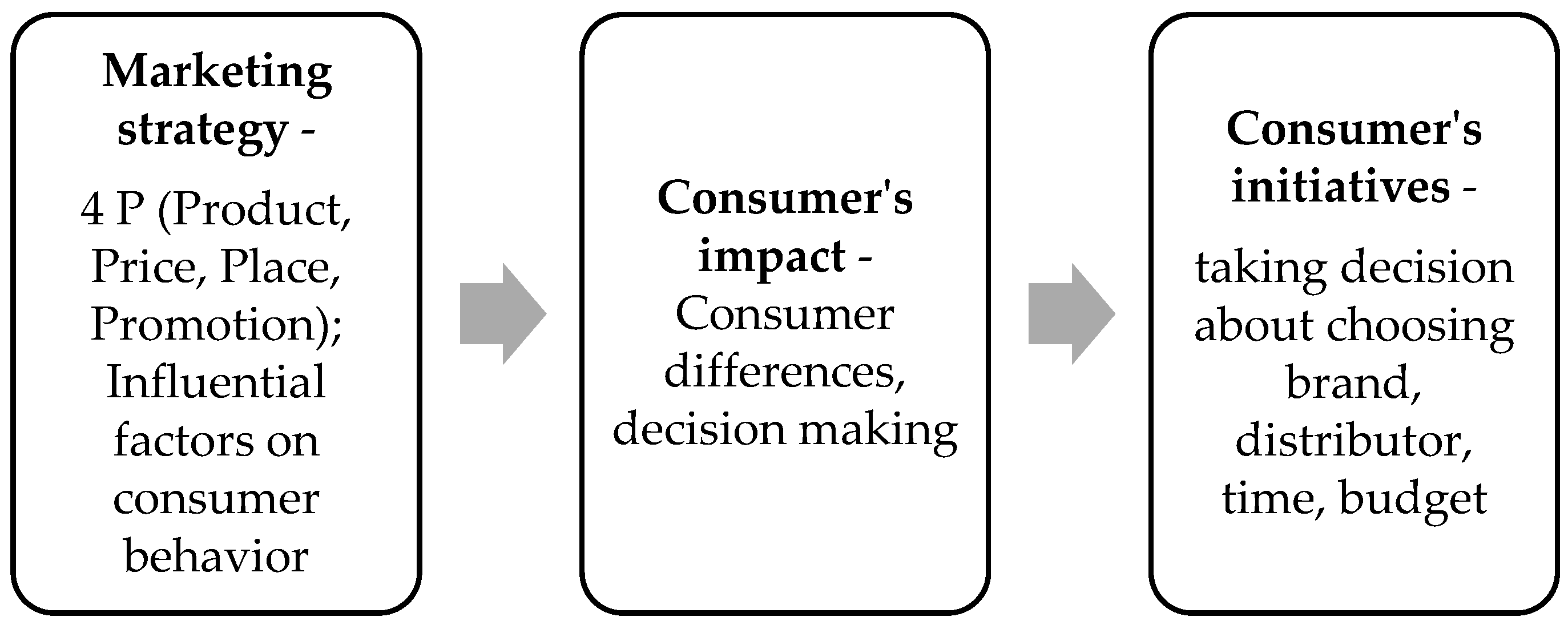
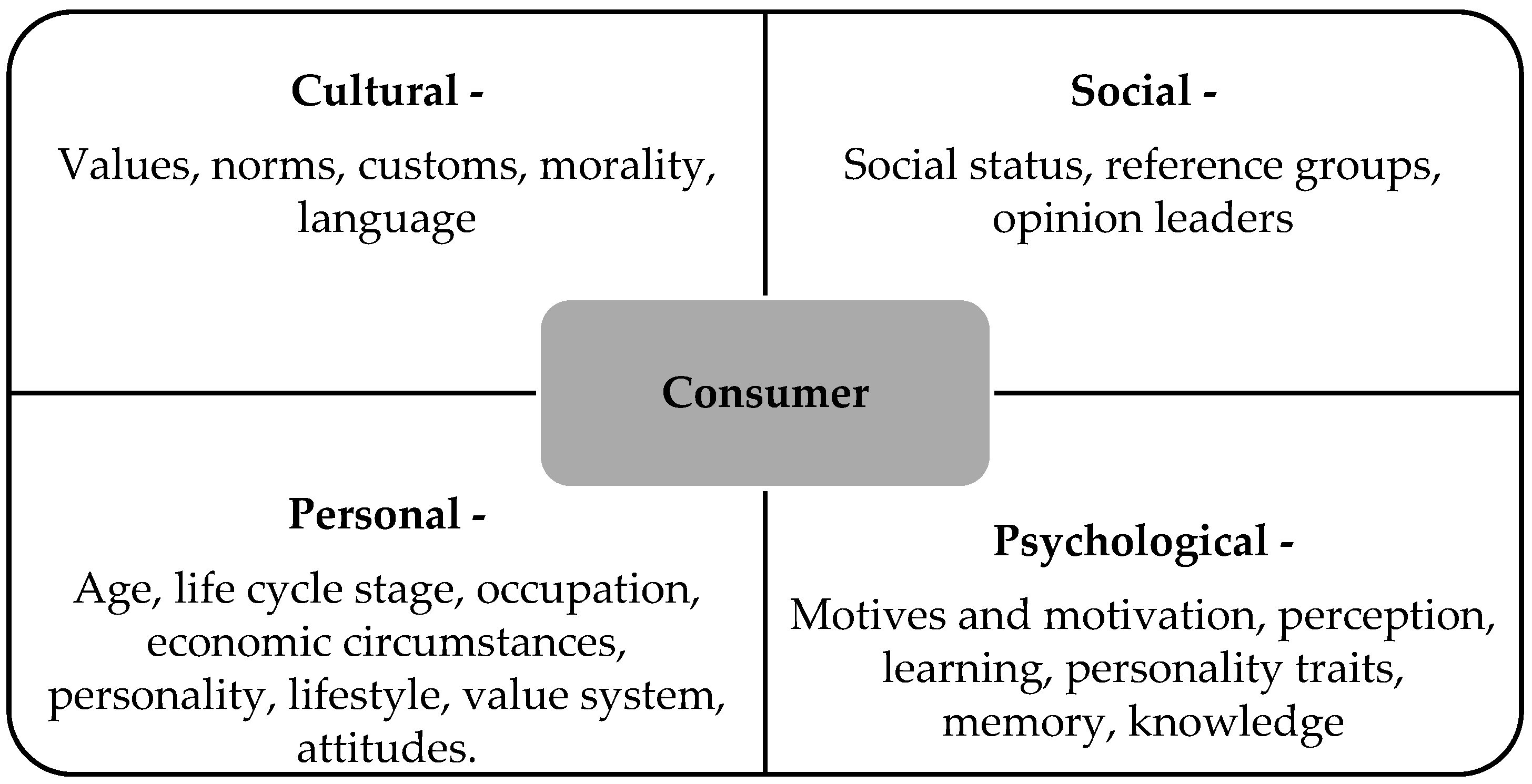

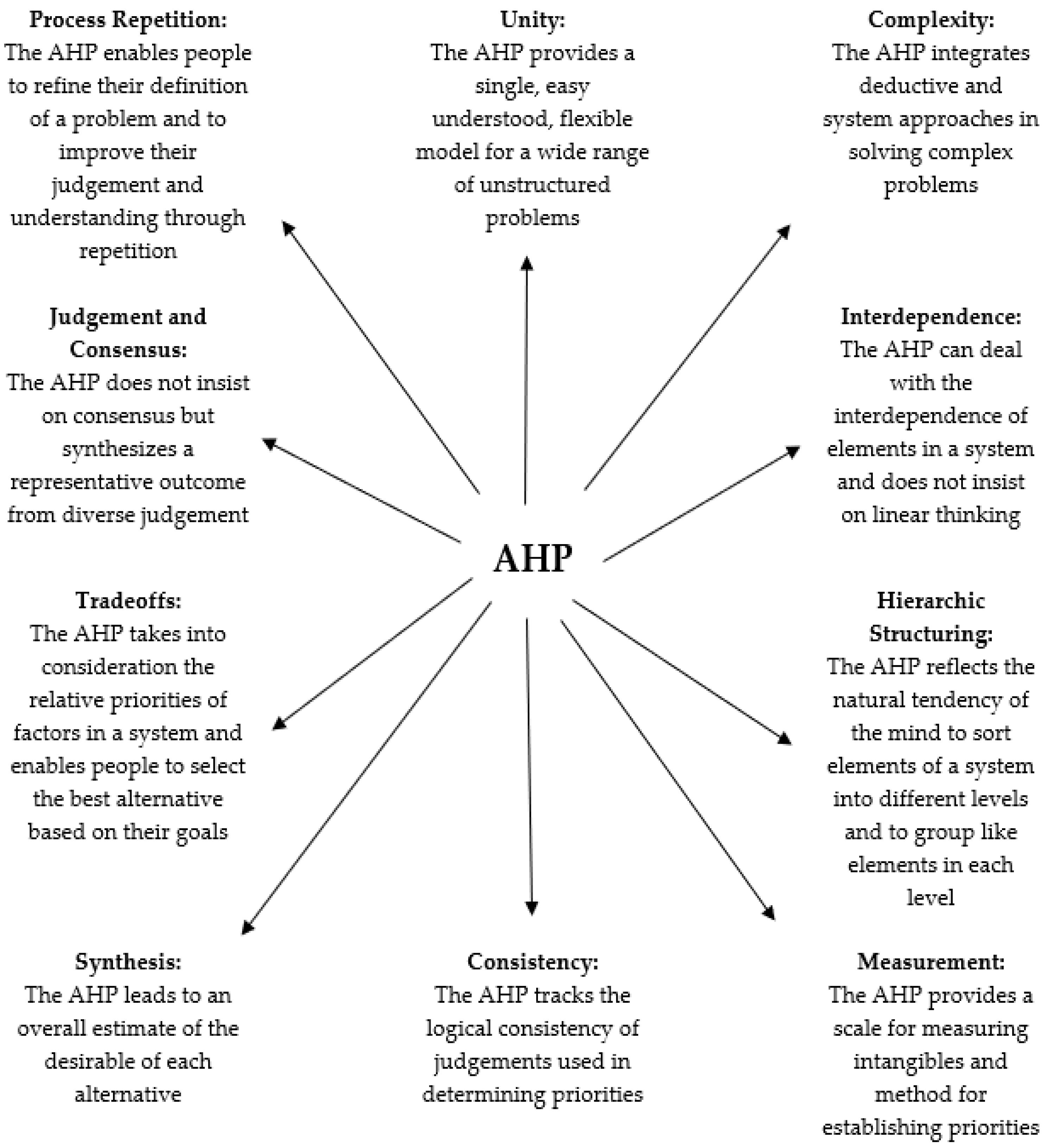
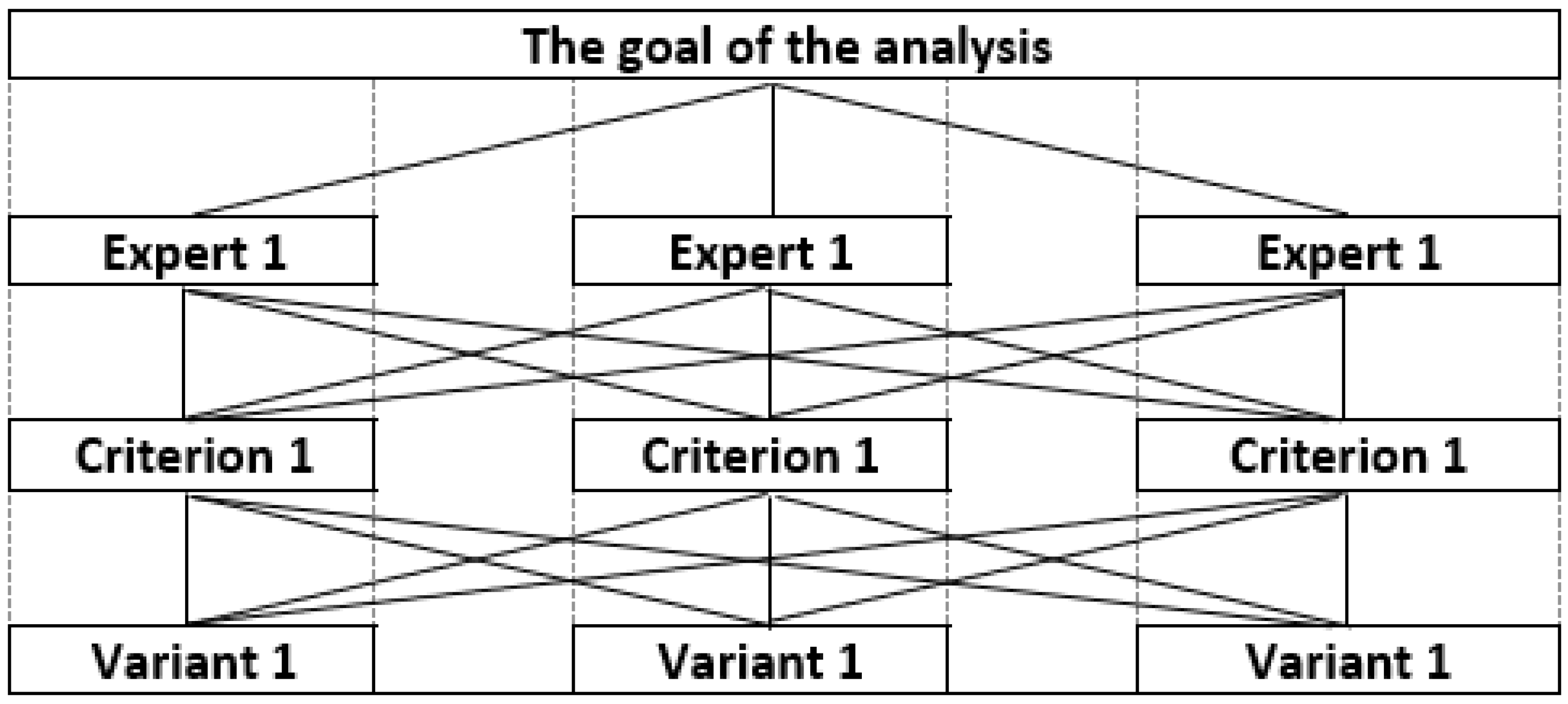

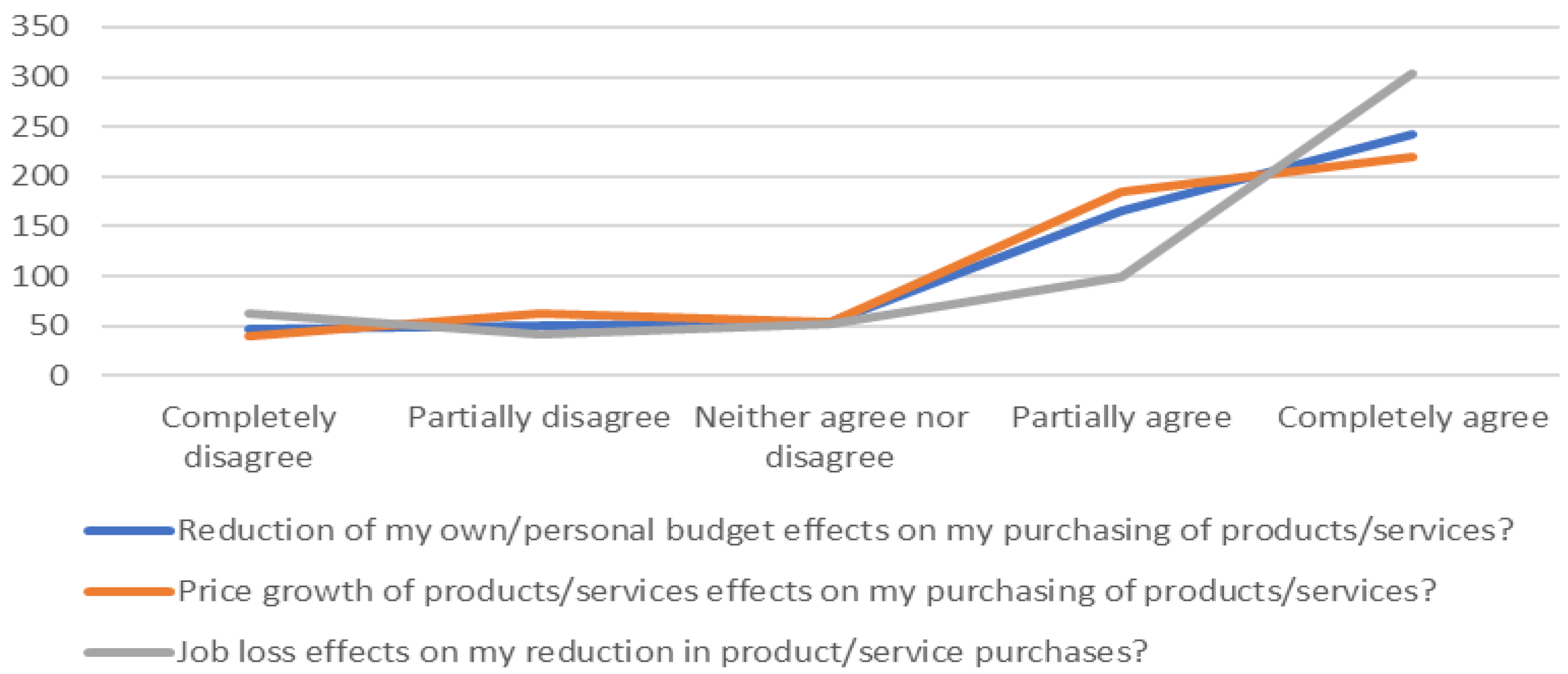
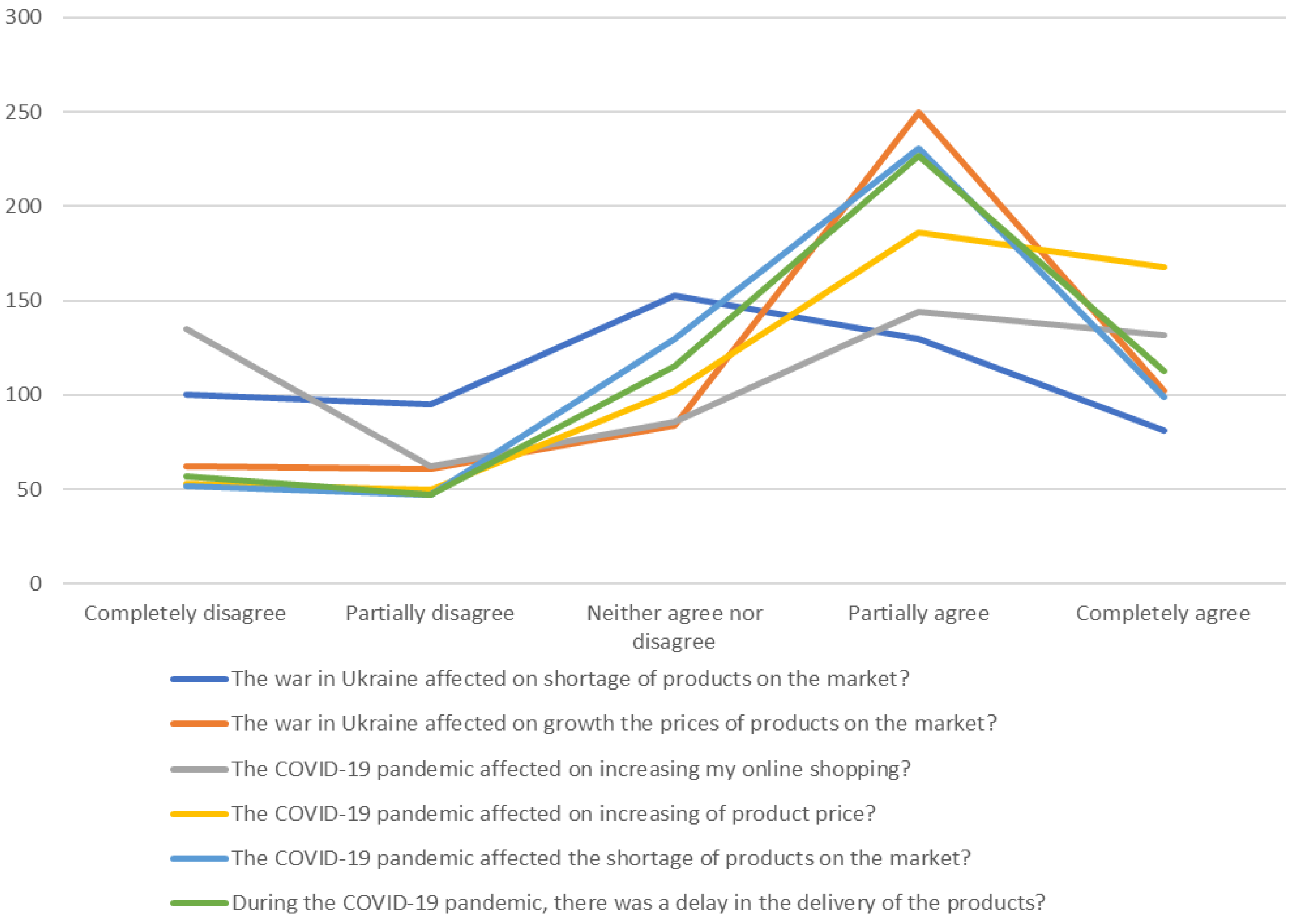
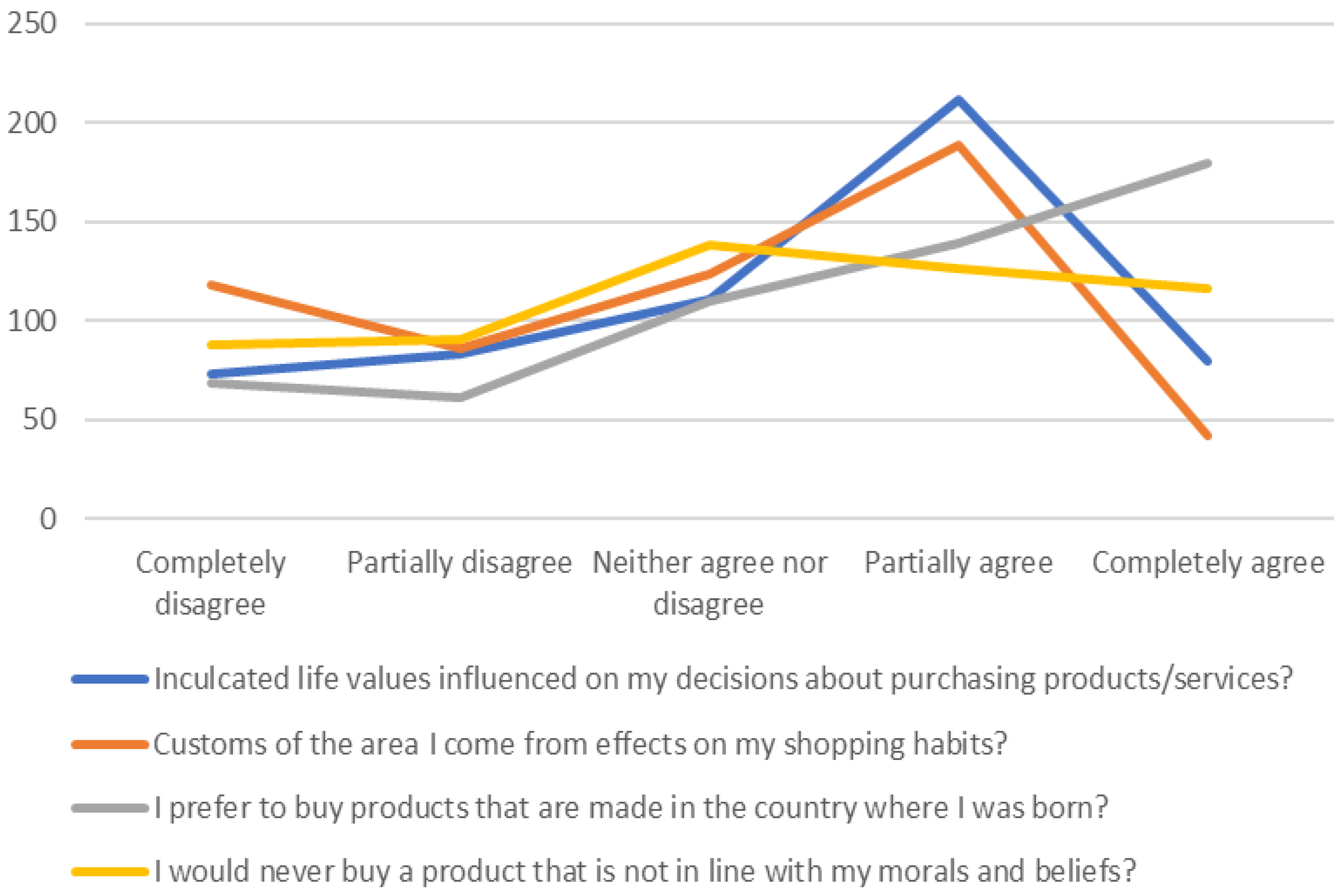
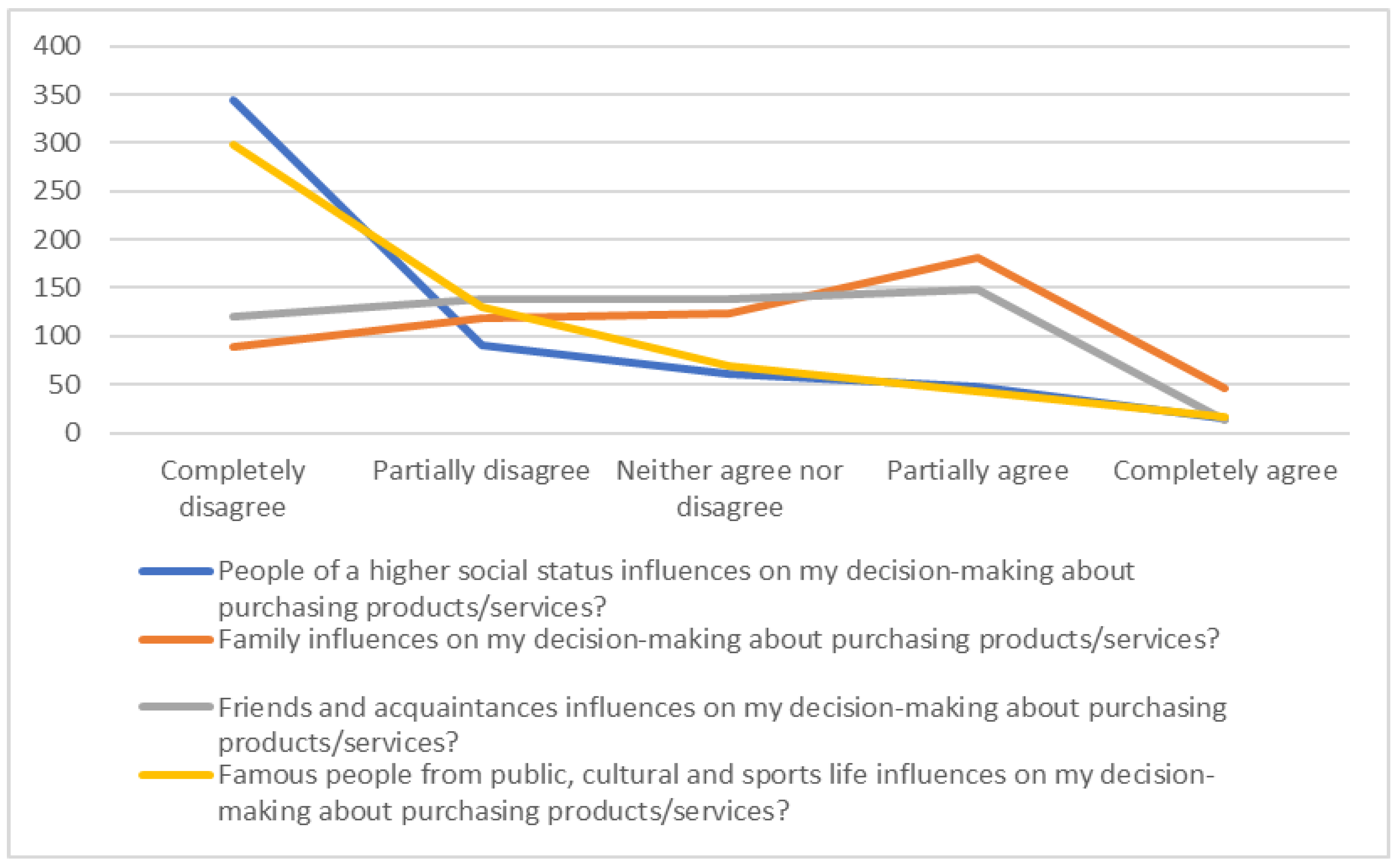
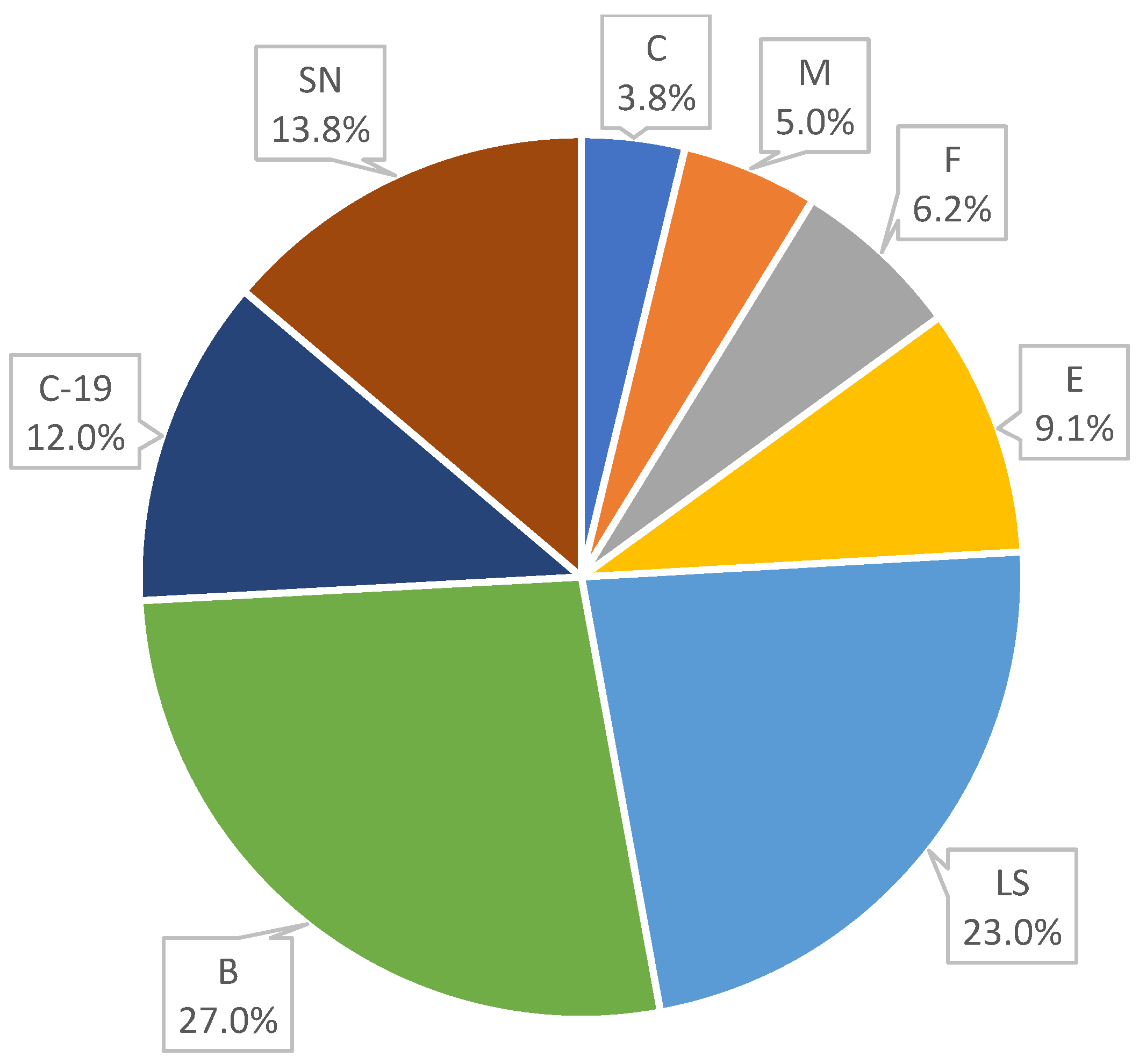
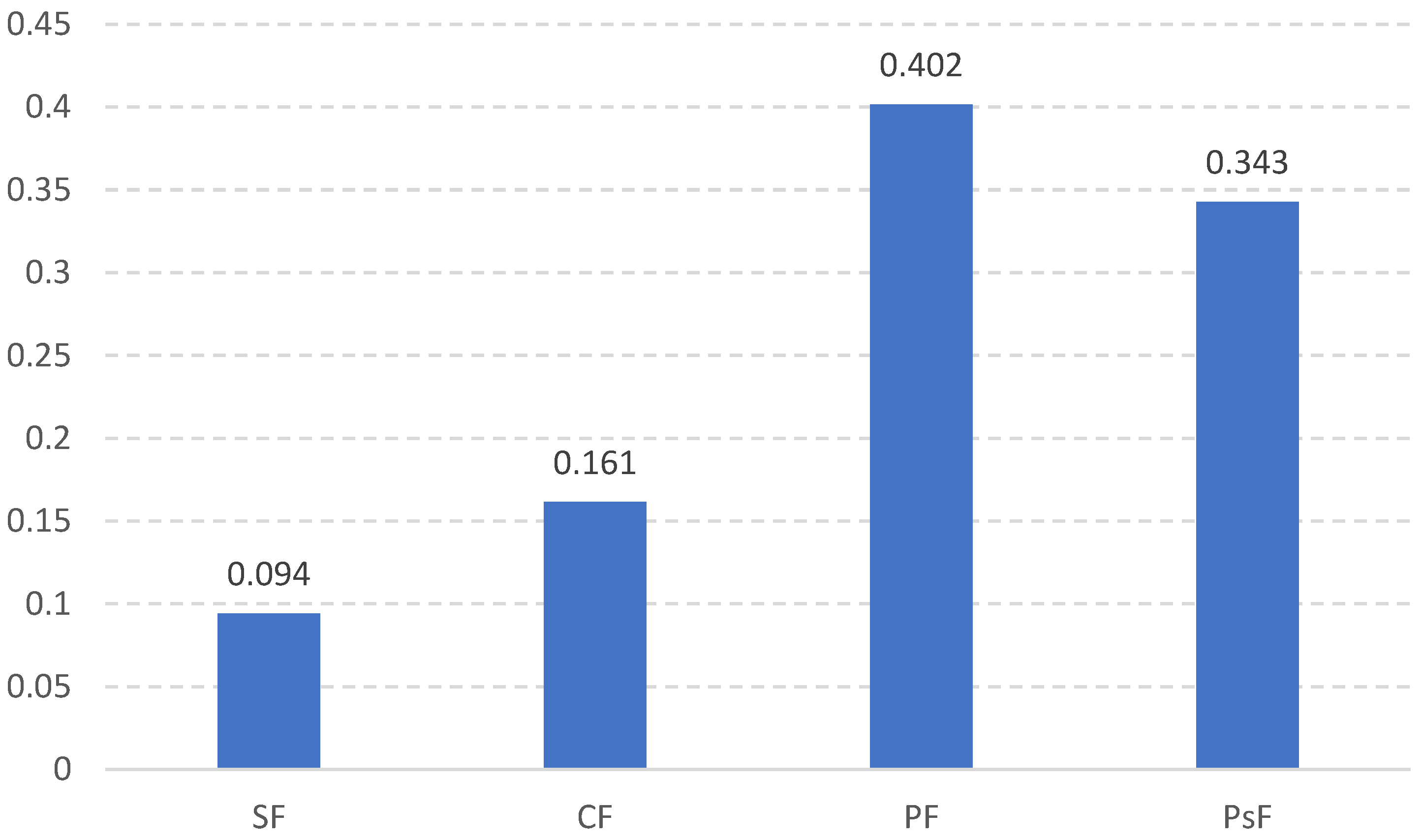
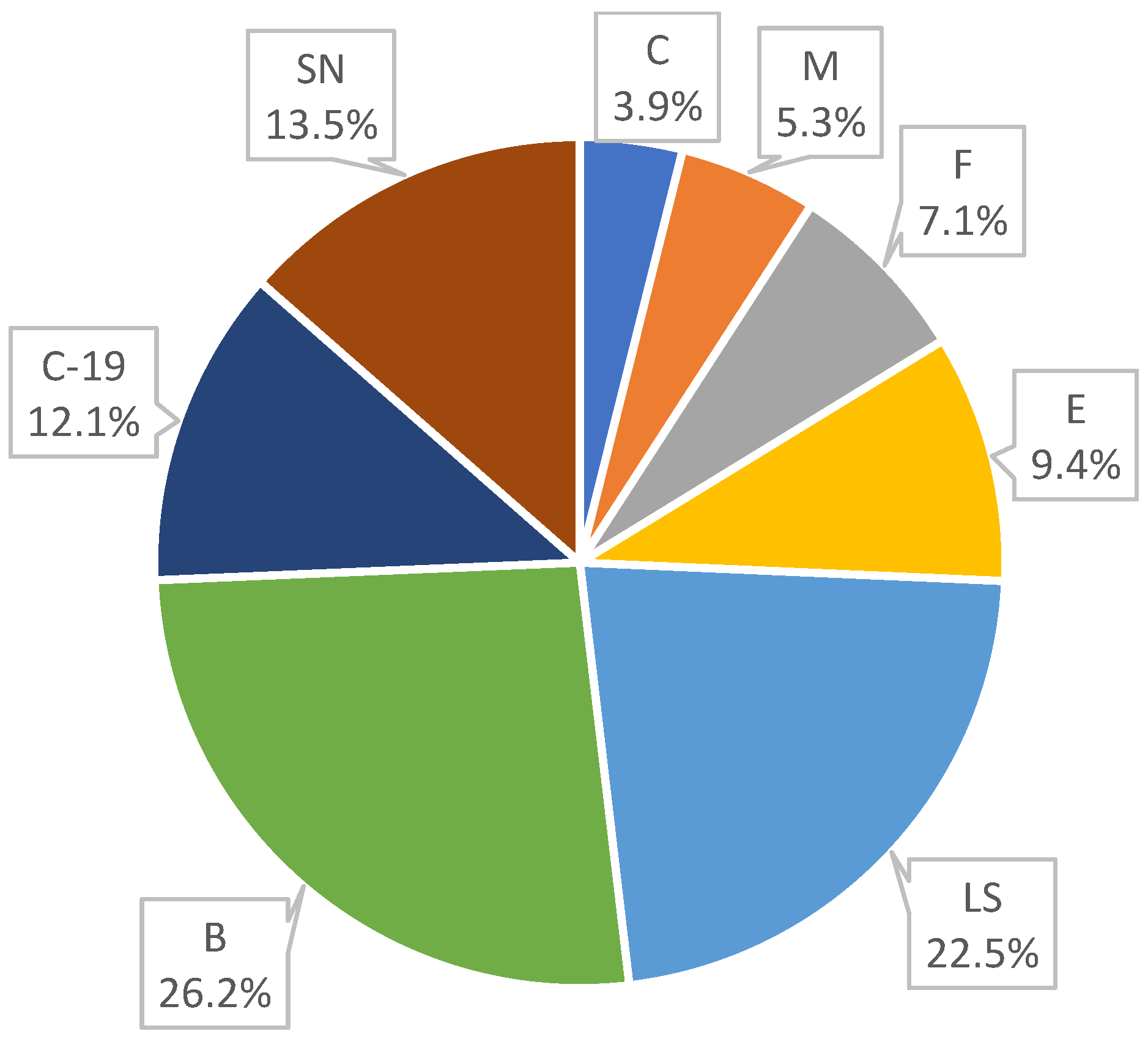
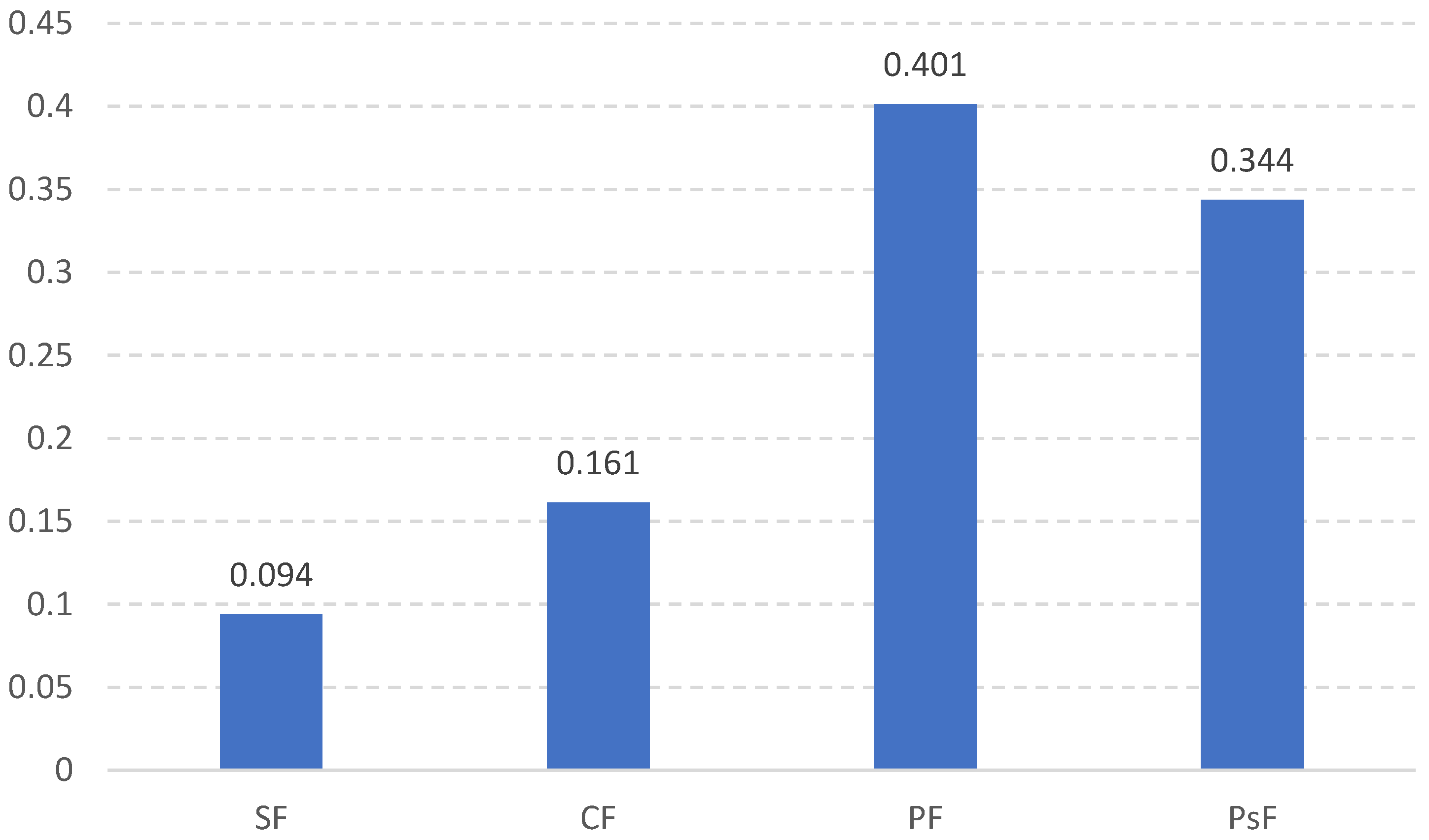
| Gender | Number |
|---|---|
| Male | 201 |
| Female | 358 |
| Age | Number |
| 18–25 | 134 |
| 26–35 | 117 |
| 36–45 | 173 |
| 46–55 | 79 |
| 56+ | 56 |
| Employment status | Number |
| Unemployed | 148 |
| Employed | 411 |
| Marital status | Number |
| Not married | 241 |
| Married | 318 |
| Monthly income | Number |
| Up to EUR 499 | 127 |
| EUR 500–799 | 83 |
| EUR 800–1099 | 153 |
| Above EUR 1099 | 196 |
| Variants/Criteria | C | M | FP | E | LS | B | C-19 | SN |
|---|---|---|---|---|---|---|---|---|
| SF | 0.141 | 0.088 | 0.098 | 0.074 | 0.088 | 0.106 | 0.080 | 0.096 |
| CF | 0.141 | 0.158 | 0.145 | 0.171 | 0.180 | 0.150 | 0.160 | 0.161 |
| PF | 0.455 | 0.482 | 0.327 | 0.471 | 0.460 | 0.435 | 0.294 | 0.277 |
| PsF | 0.263 | 0.272 | 0.430 | 0.284 | 0.272 | 0.309 | 0.466 | 0.466 |
| Matrix | ||||||||
|---|---|---|---|---|---|---|---|---|
| V1 | V2 | V3 | V4 | V5 | V6 | V7 | V8 | |
| λmax | 4.01 | 4.01 | 4.13 | 4.05 | 4.09 | 4.12 | 4.13 | 4.03 |
| RI | 0.9 | 0.9 | 0.9 | 0.9 | 0.9 | 0.9 | 0.9 | 0.9 |
| CI | 0.00 | 0.00 | 0.04 | 0.02 | 0.03 | 0.04 | 0.04 | 0.01 |
| CR | 0.00 | 0.01 | 0.05 | 0.02 | 0.03 | 0.05 | 0.05 | 0.01 |
| C | M | FP | E | LS | B | C-19 | SN | Priorities | Rang | |
|---|---|---|---|---|---|---|---|---|---|---|
| SF | 0.01 | 0.00 | 0.01 | 0.01 | 0.02 | 0.03 | 0.01 | 0.01 | 0.09 | 4 |
| CF | 0.01 | 0.01 | 0.01 | 0.02 | 0.04 | 0.04 | 0.02 | 0.02 | 0.16 | 3 |
| PF | 0.02 | 0.03 | 0.02 | 0.04 | 0.10 | 0.11 | 0.04 | 0.04 | 0.40 | 1 |
| PsF | 0.01 | 0.01 | 0.03 | 0.03 | 0.06 | 0.08 | 0.06 | 0.06 | 0.34 | 2 |
| Weight vector | (0.04) | (0.05) | (0.07) | (0.09) | (0.22) | (0.26) | (0.12) | (0.14) | 1.00 | |
| Rank | 8 | 7 | 6 | 5 | 2 | 1 | 4 | 3 |
Disclaimer/Publisher’s Note: The statements, opinions and data contained in all publications are solely those of the individual author(s) and contributor(s) and not of MDPI and/or the editor(s). MDPI and/or the editor(s) disclaim responsibility for any injury to people or property resulting from any ideas, methods, instructions or products referred to in the content. |
© 2023 by the authors. Licensee MDPI, Basel, Switzerland. This article is an open access article distributed under the terms and conditions of the Creative Commons Attribution (CC BY) license (https://creativecommons.org/licenses/by/4.0/).
Share and Cite
Šostar, M.; Ristanović, V. Assessment of Influencing Factors on Consumer Behavior Using the AHP Model. Sustainability 2023, 15, 10341. https://doi.org/10.3390/su151310341
Šostar M, Ristanović V. Assessment of Influencing Factors on Consumer Behavior Using the AHP Model. Sustainability. 2023; 15(13):10341. https://doi.org/10.3390/su151310341
Chicago/Turabian StyleŠostar, Marko, and Vladimir Ristanović. 2023. "Assessment of Influencing Factors on Consumer Behavior Using the AHP Model" Sustainability 15, no. 13: 10341. https://doi.org/10.3390/su151310341
APA StyleŠostar, M., & Ristanović, V. (2023). Assessment of Influencing Factors on Consumer Behavior Using the AHP Model. Sustainability, 15(13), 10341. https://doi.org/10.3390/su151310341









